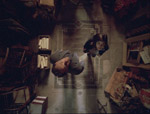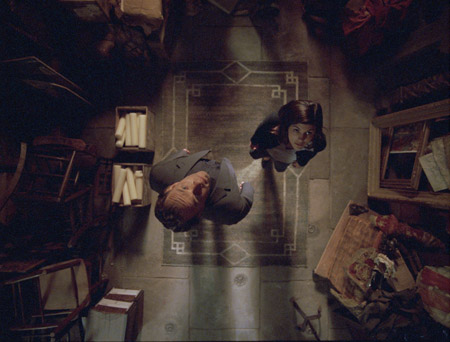The Da Vinci Code
 A sandstorm of media insanity has preceded this movie like an army of Oprah devotees marching into the streets to beat you in the head until you buy the self-professed prophet’s most treasured book of the month, week, hour or minute… I have not read the book, but I will make no comparisons to it in my evaluation of the movie. On its own merits…
A sandstorm of media insanity has preceded this movie like an army of Oprah devotees marching into the streets to beat you in the head until you buy the self-professed prophet’s most treasured book of the month, week, hour or minute… I have not read the book, but I will make no comparisons to it in my evaluation of the movie. On its own merits…

Or should I have titled this commentary, “Much Ado About Nothing?”
A sandstorm of media insanity has preceded this movie like an army of Oprah devotees marching into the streets to beat you in the head until you buy the self-proclaimed prophet’s most treasured book of the month, week, hour or minute… I have not read the book, but I will make no comparisons to it in my evaluation of the movie. On its own merits, “The Da Vinci Code,” directed by that manufacturer of contrived melodrama, Ron Howard, is a failure.
Ominous strings tremble while the pristinely coordinated title card fades in. This should have already started your cliche-o-meter, which will click over to “2” in the very first scene as a man is running away from something or someone. A hooded figure is pursuing him. It’s not enough for the society to which he belongs to be kept secret, they must skulk around in hoods. Does anyone ever bother to ask why? I mean, think about it… If no one knows the society exists, why would its members need to protect their identities? The guy could just be some Joe Blow off the street involved in a random act of violence. Which makes one wonder why they always send their best to do the job when they could have just hired a thug from the Vice Lords. If he screws up and gets killed, nobody’s going to suspect the Society Which For All Intents and Purposes Does Not Exist.
But before we continue slogging through the idiocy, allow me to discuss the premise for the five or six people on the planet who haven’t been pummeled into a coma by the media. Based on Dan Brown’s novel, “The Da Vinci Code” centers on the concept that Jesus Christ was mortal and has descendants. As the story goes, the proof of this resides in the real “holy grail” which is not a cup, but Mary Magdalene. There are, however, secret societies inside (Opus Dei) and outside the Vatican (the Priory of Sion) which keep this secret hidden from the general public.
The cloaked, shadowy figure (read: Creepy Albinish Blonde Guy, also known as Paul Bettany) chasing down Jacques Sauniere (Jean-Pierre Marielle, whose talent as one of France’s greatest actors is wasted in too brief a role) is a recruit of Opus Dei. His devotion is such that he flails himself daily as penance. However, his primary purpose is to add menace to the face of an organization whose corruptions are easily glossed over to make way for the real central focus of the film — Robert Langdon (Tom Hanks).
I won’t fault Hanks. He’s a good actor. The fault I believe is Dan Brown’s. The book and the film place Langdon as a Professor of Religious Symbology at Harvard. Why is it always Harvard? Since the legend involves an alleged cover-up by the Vatican, then why not a Professor of Ecumenical Studies at Geneva, Oxford, Cambridge, or any number of institutions that undoubtedly contribute just as much if not more to the panacea of theological survey than Harvard? Writers and screenwriters unfamiliar with academia generally pick Harvard because it’s immediately recognizable and sounds important. The ultimate exercise in vanity is brandished before the audience as we see Langdon touring the lecture circuit and signing books. The worst writers and directors insert themselves (well, more famous and influential versions of themselves) into prominent roles in their own stories. Dan Brown, it so happens, was an English teacher at Exeter.
So Brown… I mean Langdon is recruited by the French police to help investigate the murder of Sauniere because there’s religious symbology involved. And this is where the story gets pretty muddy, folks. Beginning with the crime scene at the Louvre, Langdon and his plucky and — surprise — beautiful investigator sidekick Sophie Neveu (Audrey Tautou) follow a series of cryptic messages, speaking in hushed tones, walking around in the dark. Why? They’re not burglars. They’re investigators let in by the building management under probable cause, no doubt. If examining a crime scene, it makes perfect sense to throw on all the house lights and speak normally. Note: The dimly lit photo I used for this review is indicative of about 90 percent of the shots in the film.
The problem I have with the film is not the general premise… although, speaking as an atheist, I have to say questioning the divinity of a religious figure is a bit superfluous if no one has yet archaeologically substantiated his existence to begin with. Conspiracy theorists love to take the long way around at solving mysteries. But, assuming that there was a Christ, the film demonstrates that it is aware of its own idiocy yet ineptly trudges on just to capitalize off the immensely popular book. It should be noted that Brown’s book is a work of fiction. However, leaving the book out of the picture, and focusing only on the logic in the film, it still reeks of absurdity.
For example, when deciphering various anagrams, Langdon and Neveu construct multiple possibilities before arbitrarily deciding on the one that best fits their presuppositions. Lacking a primer, not even a scholar has a legitimate reason to assume greater validity of one unscrambling over another. Selective acceptance of tenuous evidence to favor a conjectural hypothesis toward which one is religiously predisposed? Unimaginable!
Science, on the other hand, doesn’t work this way… nor do windmills. But nevermind. Other figures come into the story including Captain Fache (Jean Reno), of whom Neveu is suspicious though we’re never really given a clear reason for that suspicion. It turns out later that he, and potentially other trusted people, are up to no good. But this reduces the film to a series of cheap twists without character development to be much concerned or dismayed by them. The characters who sense imminent betrayal have no reason to before it happens. It’s only acceptable in hindsight, but that’s extremely poor writing.
There are many angles by which the film betrays the ignorance and incompetency of the writer and director. In one instance a message warns someone of grave danger, but not immediately what that danger is. Oh, that’s really helpful. Flashbacks, used throughout the film, are grainy and oversaturated in diffuse glow. The dialogue already leads into the flashback, so either the dialogue is unnecessary, or the visual effects are. In every instance of clue gathering, Neveu and Langdon utter their observations aloud, in constant and overacted disbelief (nevermind the outlandish theory to which they’ve already subscribed), as if they’re superheros in a comic book.
Eventually their search leads them to seek the assistance of Sir Leigh Teabing (Ian McKellen), the Fletcher Prouty of London — though slightly more credible. But rather than drone on about the scholarly Teabing’s role in this maudlin drama, I’d like to switch gears. I have a thought. I was reminded at some point of the unfolding series of events in what I consider to be an addictive game. In “Myst,” you find yourself on an island without any background on why you’re there or what you must do. Working your way around the island, a story unfolds as you investigate and digest your surroundings. Your sense of urgency and desperation is not created by anticipation of impending events that might befall you (mere survival is not the point of the game). Instead, the agitation you feel is claustrophobic in nature. If you’re like me, you’ve spent nights plagued with one question, “How the hell do I get off this damned island?” When you do, the solution is both maddening and tremendously delightful. You’ll be flummoxed that the solution was under your nose the entire time, but elated to know the game had to present significant cognitive obstacles to delay you. Such an involving and challenging story leaves you feeling greatly rewarded.
“The Da Vinci Code” does no such thing. It doesn’t require the audience to think. It only requires us to be passive observers to a series of haphazardly connected dots that could be rearranged in any other order to form another, equally plausible (or implausible) explanation than the one they finally come up with. There are lots of details in the movie, but they never come together in a cogent narrative. In fact, they serve to obfuscate just how vacuous the story is — an agonizingly empty 149 minutes of cinematic garbage. It’s as if Goldsman and Howard attended the Bowfinger Academy of Filmmaking — “What difference does it make what he says? It’s an action movie. All he’s gotta do is run. He runs away from the aliens, he runs toward the aliens, he runs away from the aliens, he runs…” Replace aliens with Opus Dei and the Priory of Sion and you get the picture, entirely.
Finally, the movie’s most disarmingly idiotic component is the tacked on disclaimer scene at the end. I’m not spoiling anything by telling you that Langdon does pull the “it’s what you believe that matters most” copout. Why? If the film, its creators, or even the characters within the story, intended to stir up so much shit… why back down now? By Law of Parsimony (i.e. if one has two equally effective explanations, the one invoking fewer extraneous entities is the more plausible one), the answer should be obvious: In order to appeal to the broadest audience possible, and therefore to secure the largest grosses. This isn’t about telling a great story. It’s about throwing together seemingly clandestine yet befuddlingly moronic and needlessly Rube Golbergian methods to conceal a so-called “secret”… one which has been a subject of public debate amongst scholars for quite some time. In other words, after all the handwaving and the hype, you discover that the real secret to “The Da Vinci Code” is that there is no secret.
 The Da Vinci Code • Dolby® Digital surround sound in select theatres • Running Time: 149 minutes • MPAA Rating: PG-13 for disturbing images, violence, some nudity, thematic material, brief drug references and sexual content. • Distributed by Columbia Pictures
The Da Vinci Code • Dolby® Digital surround sound in select theatres • Running Time: 149 minutes • MPAA Rating: PG-13 for disturbing images, violence, some nudity, thematic material, brief drug references and sexual content. • Distributed by Columbia Pictures